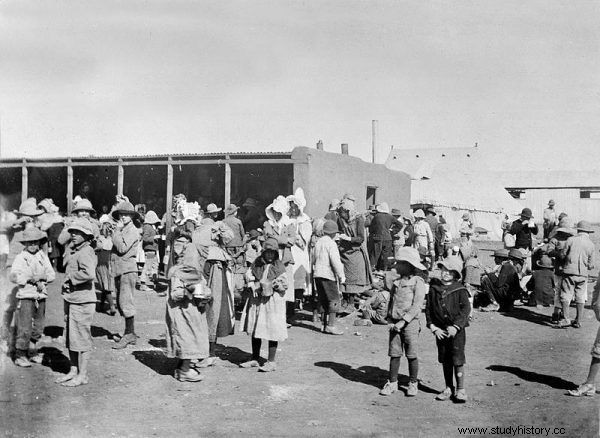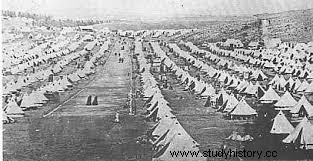It was supposed to be a "humanitarian war", without unnecessary bloodshed, senseless victims and violence. It quickly turned into a testing ground, where solutions that were later used in both world conflicts were tested - including concentration camps that the British had created long before the Germans had the same idea ...
According to historians, it was the bloodiest and most costly war in the British Empire since the Napoleonic era. The clashes with the Boers (descendants of the Dutch settlers in South Africa) could have probably been avoided if not for the stubbornness and greed of both sides. The British, however, after the humiliation in the First Boer War, did not intend to give up. The more so because in the independent republics of Transvaal and Orania in 1886 huge deposits of diamonds and gold were found.

Today hardly anyone remembers that the British established concentration camps during the Boer Wars
It was only a matter of time before the conflict escalated. For London demanded full control of the gold-bearing territories, to which the Boers, of course, did not want to agree. On October 11, 1899, the Second Boer War broke out. Neither side probably imagined how bloody it would take.
White Glove Genocide
Under the pretext of saving the black people of Africa from the yoke imposed by the Boers, soldiers of the British Empire entered the Transvaal and Orania using scorched earth tactics. Their campaign was based on arson (for this reason one of the British satirists even suggested introducing a new military decoration - the Order of the Torch). As one of the soldiers recalled:
The country was almost completely ravaged. You can walk many miles - you can actually walk for weeks without seeing any signs of life or crops. There are only burned farms and a desert around.

Boer children and women in a concentration camp
The worst was yet to come. In 1900, the Boers began to fight guerrilla fights, and the scales of victory turned to their side. Then the decision was made in London to deal with the local population by locking them in concentration camps . The "invention" itself was not new - it had already been used in Cuba by the Spaniards. The British Empire, however, managed to "perfect" it significantly. What were the conditions in these African extermination centers? Andrea Pitzer in the book The Night That Never Ends. History of concentration camps ”describes:
In the sun-scorched steppe, at the foot of a low hill, stood uneven rows of round tents; at the end of the camp, a mortuary-tent was erected and the hospital buildings covered with tin roofs. (...) With time, such shelters were to run out, so the new arrivals slept on carts or in railway carriages (...).
There was no water and no soap; measles was spreading. The corpse was sometimes left in tents long enough that it was beginning to decompose.
This was the situation in the centers where Boers were detained. Due to the mass burning of entire villages, the British had to face another "problem" - the natives who had become refugees in their own country through the war. Separate camps were created for them, in which they generously received free food and shelter. Or at least that was the theory. In fact, the managers of these outposts were guided by the slogan of Cape Colony Governor Alfred Milner:"All you have to do is sacrifice the 'nigger' and the game becomes easy."
"We locked women in camps, (...) we kill them with thousands"
As it turned out later, the British, under the guise of helping black Africans, hand in hand with the Boers, pursued a policy of racial segregation, aimed at depriving natives of civil rights. In The Night That Doesn't End, Andrea Pitzer relates:
These people were left to their own devices during the conflict. At the end of the war, a total of more than one hundred fifteen thousand seven hundred black Africans were held in British camps - without tin hospital barracks, without providing clothing and mattresses for naked and sleeping refugees, and with no hope of feeding everyone.
When Boers were given tents in "their" camps, the forced inhabitants of "black" institutions had to deal with rags, sticks, sheet metal and blankets. They were not given free rations (it was assumed that they had other needs in this regard anyway). In one of the camps, the population had nothing to eat except the corpses of cattle that had died from diseases.
Widespread hunger, ditch latrines and increasing overpopulation soon "bore fruit" in the form of an epidemic. Pitzer describes:“The refugees suffered from dysentery, typhus, chicken pox, measles and pneumonia. (…) In many camps there was a shortage of hospital nurses and nurses. ”
Mothers have been blamed for high infant mortality rates, arguing that "the natives do not seem to care for the children until they are of an age where they become useful".
Bloody Loss Account
The government in London was well aware of the conditions in which the people confined in the camps were. Missionaries and representatives of humanitarian organizations have repeatedly drawn attention to the crisis in South Africa.

The Second Boer War became a prelude to the next tragic events of the 20th century
In the House of Commons, Lloyd George even announced that: "Applying the term" refugees "to these camps is the height of self-deception. These aren't any refugee camps. These are concentration camps established by the army as a result of military operations on the battlefield ” . However, this did not change the situation in the institutions. Andrea Pitzer lists:
Until peace was made on the steppe, a total of sixty-six camps had been established, in which more than one hundred and fifteen thousand black Africans were held. Of this number, more than fourteen thousand did not survive, or about 12% of those who passed through the camps.
The camps intended for the descendants of the Dutch also took a bloody toll. According to estimates by historian Peter Warwick, quoted by Pitzer in his book "The Night That Doesn't End":
Until the Boers surrender, which took place on the last day of May 1902, (...) over twenty-seven thousand interned Boers had died, so "probably twice as many as the number of those killed on the battlefield on both sides", and at the same time about 10 % of the population. Nearly 80% of the dead were children.
The Second Boer War became a prelude to the next tragic events of the 20th century - those known, such as the Holocaust of the Jews during World War II, and those forgotten - such as the brutal suppression of the Herer rebellion in German South-West Africa. One thing has remained unchanged - the bestial nature of the concentration camps, which are still in operation in many parts of the globe ...
